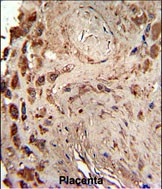PRKRA Antibody (S246)
Purified Rabbit Polyclonal Antibody (Pab)
- SPECIFICATION
- CITATIONS
- PROTOCOLS
- BACKGROUND

Application
| FC, IHC-P, WB, E |
|---|---|
| Primary Accession | O75569 |
| Other Accession | Q4V8C7, Q2HJ92 |
| Reactivity | Human |
| Predicted | Bovine, Rat |
| Host | Rabbit |
| Clonality | Polyclonal |
| Isotype | Rabbit IgG |
| Calculated MW | 34404 Da |
| Antigen Region | 225-252 aa |
| Gene ID | 8575 |
|---|---|
| Other Names | Interferon-inducible double-stranded RNA-dependent protein kinase activator A, PKR-associated protein X, PKR-associating protein X, Protein activator of the interferon-induced protein kinase, Protein kinase, interferon-inducible double-stranded RNA-dependent activator, PRKRA, PACT, RAX |
| Target/Specificity | This PRKRA antibody is generated from rabbits immunized with a KLH conjugated synthetic peptide between 225-252 amino acids from human PRKRA. |
| Dilution | FC~~1:10~50 IHC-P~~1:50~100 WB~~1:1000 E~~Use at an assay dependent concentration. |
| Format | Purified polyclonal antibody supplied in PBS with 0.09% (W/V) sodium azide. This antibody is purified through a protein A column, followed by peptide affinity purification. |
| Storage | Maintain refrigerated at 2-8°C for up to 2 weeks. For long term storage store at -20°C in small aliquots to prevent freeze-thaw cycles. |
| Precautions | PRKRA Antibody (S246) is for research use only and not for use in diagnostic or therapeutic procedures. |
| Name | PRKRA |
|---|---|
| Synonyms | PACT, RAX |
| Function | Activates EIF2AK2/PKR in the absence of double-stranded RNA (dsRNA), leading to phosphorylation of EIF2S1/EFI2-alpha and inhibition of translation and induction of apoptosis. Required for siRNA production by DICER1 and for subsequent siRNA-mediated post- transcriptional gene silencing. Does not seem to be required for processing of pre-miRNA to miRNA by DICER1. Promotes UBC9-p53/TP53 association and sumoylation and phosphorylation of p53/TP53 at 'Lys- 386' at 'Ser-392' respectively and enhances its activity in a EIF2AK2/PKR-dependent manner (By similarity). |
| Cellular Location | Cytoplasm, perinuclear region. Cytoplasm. |

Thousands of laboratories across the world have published research that depended on the performance of antibodies from Abcepta to advance their research. Check out links to articles that cite our products in major peer-reviewed journals, organized by research category.
info@abcepta.com, and receive a free "I Love Antibodies" mug.
Provided below are standard protocols that you may find useful for product applications.
Background
PRKRA appears to have a pro-apoptotic function that may be suppressed in the presence of growth factor. It activates EIF2AK2 in the absence of double-stranded RNA (dsRNA).
References
Seibler,P., Lancet Neurol 7 (5), 380-381 (2008)
Kok,K.H., J. Biol. Chem. 282 (24), 17649-17657 (2007)
Patel,R.C., EMBO J. 17 (15), 4379-4390 (1998)
If you have used an Abcepta product and would like to share how it has performed, please click on the "Submit Review" button and provide the requested information. Our staff will examine and post your review and contact you if needed.
If you have any additional inquiries please email technical services at tech@abcepta.com.













 Foundational characteristics of cancer include proliferation, angiogenesis, migration, evasion of apoptosis, and cellular immortality. Find key markers for these cellular processes and antibodies to detect them.
Foundational characteristics of cancer include proliferation, angiogenesis, migration, evasion of apoptosis, and cellular immortality. Find key markers for these cellular processes and antibodies to detect them. The SUMOplot™ Analysis Program predicts and scores sumoylation sites in your protein. SUMOylation is a post-translational modification involved in various cellular processes, such as nuclear-cytosolic transport, transcriptional regulation, apoptosis, protein stability, response to stress, and progression through the cell cycle.
The SUMOplot™ Analysis Program predicts and scores sumoylation sites in your protein. SUMOylation is a post-translational modification involved in various cellular processes, such as nuclear-cytosolic transport, transcriptional regulation, apoptosis, protein stability, response to stress, and progression through the cell cycle. The Autophagy Receptor Motif Plotter predicts and scores autophagy receptor binding sites in your protein. Identifying proteins connected to this pathway is critical to understanding the role of autophagy in physiological as well as pathological processes such as development, differentiation, neurodegenerative diseases, stress, infection, and cancer.
The Autophagy Receptor Motif Plotter predicts and scores autophagy receptor binding sites in your protein. Identifying proteins connected to this pathway is critical to understanding the role of autophagy in physiological as well as pathological processes such as development, differentiation, neurodegenerative diseases, stress, infection, and cancer.




